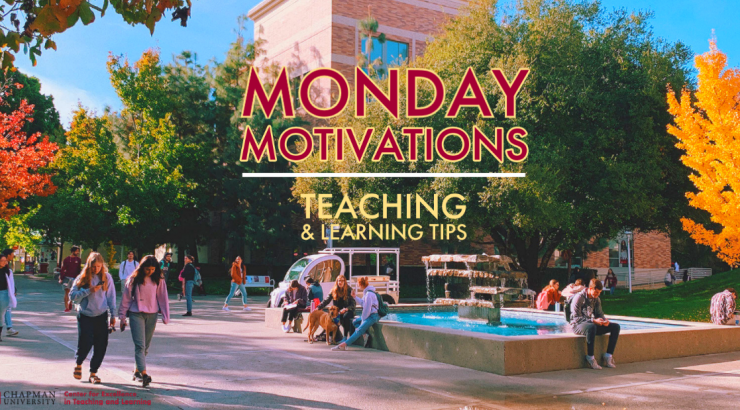
Tips for the Week of April 24, 2023
April 20, 2023
Prioritizing Self-Care is Not Being Selfish
Contrary to what many people believe, the build-up of lactic acid is not the culprit in post-workout muscle tenderness or fatigue. Instead, delayed onset muscle soreness (DOMS) is the result of microscopic damage to muscle fibers involved in exercise. Much like DOMS, Covid-19 and the pandemic left many of us with damages in the form of physical exhaustion and/or mental health challenges that continue to plague us today. With many faculty “on the verge of burnout,” it can be helpful to apply lessons learned from endurance athletes to practice self-care during the final weeks of the semester. Plan recovery breaks and fuel your body. Endurance athletes intersperse intensive workout sessions with short periods of rest or light work. They also manage their diet to aid strength building and recovery. Drink lots of water, add omega-3s (e.g., salmon), olive oil, avocados, and dark leafy greens to your diet. Lastly, plan for a memorable end-of-the-semester with your students. For ideas see last day activities and Last Day:Make It Count.
Ways to Provide Personalized Feedback on Assessments
Students are often very nervous about upcoming assessments, especially as a semester or trimester comes to a close. Many students fear opening Canvas to view their grade. Jose Bowen, author of the book Teaching Change How to Develop Independent Thinkers Using Relationships, Resilience, and Reflection (2021), argues that personalized feedback on assessments shows students we care and can lower anxiety. He suggests the following:
- Include the student’s name when writing a personal comment;
- Personalize the comment by including information on their progress in the course (e. g. “I notice that you…)”;
- Within Canvas SpeedGrader, either leave your personalized comment as a voice recording or short video. Students can hear the instructor’s empathy and inflection in their voice as they provide words of encouragement.
- Send individual students a short email (which again, within Canvas this can be done easily with “message students who).”
Finally, our words of encouragement help students continue to have a growth mindset, especially if they did not score well on the previous assessment (Cohen, 2018).
Explain the Value of Student Feedback (Course Evaluations)
In the same way that instructor feedback is designed to help learners grow, student feedback to faculty can signal areas of strength and areas that may need more development. End-of-term evaluations are a crucial part of the continuous improvement process and key to our ongoing professional development (Fiock, 2020). In addition to the required survey, you may also want to consider a supplemental, anonymous survey to gather feedback on new tools or strategies you implemented this term (e.g., active learning, Padlet). Regardless of the type of feedback survey, it’s critical that you 1) explain to students why their feedback is important to you, 2) provide examples of feedback that is useful/instructive versus feedback that is not useful, and 3) how you plan to use their feedback to improve the course.
Interested in exploring any of these ideas further or discussing how you might implement them in your own teaching practices? Is there a tip you’ve tried that you would like to share with colleagues? Contact CETL or schedule a consultation to continue the conversation.


